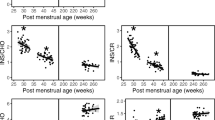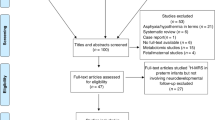Abstract
Background
Children with very low birth weight (VLBW) have a significantly increased risk of later neurodevelopmental problems, while infants born small for gestational age (SGA) at term are also at some risk of developing neurological impairment.
Objective
To investigate possible brain metabolite differences in adolescents with VLBW, SGA at term and controls by proton in vivo magnetic resonance spectroscopy (MRS) at 1.5 T.
Materials and methods
MR spectra were acquired from volumes localized in the left frontal lobe, containing mainly white matter (54 subjects). Peak areas of N-acetyl aspartate (NAA), choline (Cho) and creatine (Cr) were determined, and the peak area ratio of NAA to Cr, total Cho to Cr, or NAA to Cho calculated. Probabilistic neural network (PNN) analysis was performed utilizing the chemical shift region containing resonances from NAA, Cho and Cr as inputs.
Results
No significant difference in the peak area ratios could be found using the Kruskal-Wallis test. By application of PNN, a correct classification of 52 of the 54 adolescents with a sensitivity and specificity exceeding 93% for all groups was achieved.
Conclusion
Small, yet systematic, differences in brain metabolite distribution among the groups were confirmed by PNN analysis.




Similar content being viewed by others
References
Skranes JS, Vik T, Nilsen G, et al (1993) Cerebral magnetic-resonance-imaging (MRI) and mental and motor function of very-low-birth-weight infants at one-year of corrected age. Neuropediatrics 24:256–262
Hollo O, Rautava P, Korhonen T, et al (2002) Academic achievement of small-for-gestational-age children at age 10 years. Arch Pediatr Adolesc Med 156:179–187
Kutschera J, Urlesberger B, Maurer U, et al (2002) Small for gestational age – somatic, neurological and cognitive development until adulthood. Z Geburtshilfe Neonatol 206:65–71
Indredavik MS, Vik T, Heyerdahl S, et al (2004) Psychiatric symptoms and disorders in adolescents with low birth weight. Arch Dis Child Fetal Neonatal Ed 89:F445–F450
Evensen KA, Vik T, Helbostad J, et al (2004) Motor skills in adolescents with low birth weight. Arch Dis Child Fetal Neonatal Ed 89:F451–F455
Imamura K (2003) Proton MR spectroscopy of the brain with a focus on chemical issues. Magn Reson Med Sci 2:117–132
Arnold DL, Matthews PM (2005) Practical aspects of clinical applications of MRS in the brain. In: Young IL, Charles HC (eds) MR spectroscopy: clinical applications and techniques. Martin Dunitz, London, pp 139–159
Kreis R, Ernst T, Ross BD (1993) Development of the human brain – in-vivo quantification of metabolite and water-content with proton magnetic-resonance spectroscopy. Magn Reson Med 30:424–437
Toft PB, Leth H, Lou HC, et al (1994) T1, T2, and concentrations of brain-metabolites in neonates and adolescents estimated with H-1 MR spectroscopy. J Magn Reson Imaging 4:1–5
Kadota T, Horinouchi T, Kuroda C (2001) Development and aging of the cerebrum: assessment with proton MR spectroscopy. AJNR 22:128–135
Cady EB, Penrice J, Amess PN, et al (1996) Lactate, N-acetylaspartate, choline and creatine concentrations, and spin-spin relaxation in thalamic and occipito-parietal regions of developing human brain. Magn Reson Med 36:878–886
Kimura H, Fujii Y, Itoh S, et al (1995) Metabolic alterations in the neonate and infant brain during development – evaluation with proton MR spectroscopy. Radiology 194:483–489
Moore GJ (1998) Proton magnetic resonance spectroscopy in pediatric neuroradiology. Pediatr Radiol 28:805–814
Yeo RA, Hill D, Campbell R, et al (2000) Developmental instability and working memory ability in children: a magnetic resonance spectroscopy investigation. Dev Neuropsychol 17:143–159
Ford CC, Griffey RH, Matwiyoff NA, et al (1992) Multivoxel H-1-MRS of stroke. Neurology 42:1408–1412
Friedman SD (1999) Quantitative proton MRS predicts outcome after traumatic brain injury. Neurology 52:1384–1391
Barkovich AJ, Baranski K, Vigneron D, et al (1999) Proton MR spectroscopy for time evaluation of brain injury in asphyxiated, term neonates. AJNR 20:1399–1405
Filippi CG, Ulug AM, Deck M, et al (2002) Developmental delay in children: assessment with proton MR spectroscopy. AJNR 23:882–888
Zimmerman RA, Wang ZJ (1997) The value of proton MR spectroscopy in pediatric metabolic brain disease. AJNR 18:1872–1879
Shu SK, Ashwal S, Holshouser BA, et al (1997) Prognostic value of H-1-MRS in perinatal CNS insults. Pediatr Neurol 17:309–318
Holshouser BA, Ashwal S, Luh GY, et al (1997) Proton MR spectroscopy after acute central nervous system injury: outcome prediction in neonates, infants, and children. Radiology 202:487–496
Garnett MR, Blamire AM, Corkill RG, et al (2000) Early proton magnetic resonance spectroscopy in normal-appearing brain correlates with outcome in patients following traumatic brain injury. Brain 123:2046–2054
Usenius JP, Tuohimetsa S, Vainio P, et al (1996) Automated classification of human brain tumours by neural network analysis using in vivo H1 magnetic resonance spectroscopic metabolite phenotypes. Neuroreport 7:1597–1600
Preul MC, Caramanos Z, Collins DL, et al (1996) Accurate, noninvasive diagnosis of human brain tumors by using proton magnetic resonance spectroscopy. Nat Med 2:323–325
Bakken IJ, Axelson D, Kvistad KA, et al (1999) Applications of neural network analyses to in vivo H-1 magnetic resonance spectroscopy of epilepsy patients. Epilepsy Res 35:245–252
Axelson D, Bakken IJ, Gribbestad IS, et al (2002) Applications of neural network analyses to in vivo H-1 magnetic resonance spectroscopy of Parkinson disease patients. J Magn Reson Imaging 16:13–20
Despagne F, Massart DL (1998) Neural networks in multivariate calibration. Analyst 123:157R–178R
Skranes JS, Martinussen M, Smevik O, et al (2005) Cerebral MRI findings in very-low-birth-weight and small-for-gestational-age children at 15 years of age. Pediatr Radiol 35:758–765
Naressi A, Couturier C, Castang I, et al (2001) Java-based graphical user interface for MRUI, a software package for quantitation of in vivo/medical magnetic resonance spectroscopy signals. Comput Biol Med 31:269–286
Forshed J, Schuppe-Koistinen I, Jacobsson SP (2003) Peak alignment of NMR signals by means of a genetic algorithm. Anal Chim Acta 487:189–199
Lee GC, Woodruff DL (2004) Beam search for peak alignment of NMR signals. Anal Chim Acta 513:413–416
Specht DF (1990) Probabilistic neural networks. Neural Netw 3:109–118
Lucasius CB, Kateman G (1993) Understanding and using genetic algorithms: Part 1 Concepts, properties and context. Chem Intell Lab Syst 19:1–33
Kemsley EK (1996) Discriminant analysis of high-dimensional data: comparison of principal components analysis and partial least squares data reduction methods. Chem Intell Lab Syst 33:47–61
Meyer B, Hansen T, Nute D, et al (1991) Identification of the 1H-NMR spectra of complex oligosaccharides with artificial neural networks. Science 251:542–544
Smith LM, Chang L, Yonekura ML, et al (2001) Brain proton magnetic resonance spectroscopy and imaging in children exposed to cocaine in utero. Pediatrics 107:227–231
Horska A, Kaufmann WE, Brant LJ, et al (2002) In vivo quantitative proton MRSI study of brain development from childhood to adolescence. J Magn Reson Imaging 15:137–143
Miller SP, Vigneron DB, Henry RG, et al (2002) Serial quantitative diffusion tensor MRI of the premature brain: development in newborns with and without injury. J Magn Reson Imaging 16:621–632
Nagy Z, Westerberg H, Skare S, et al (2003) Preterm children have disturbances of white matter at 11 years of age as shown by diffusion tensor imaging. Pediatr Res 54:672–679
Skranes JS, Nilsen G, Smevik O, et al (1998) Cerebral MRI of very low birth weight children at 6 years of age compared with the findings at 1 year. Pediatr Radiol 28:471–475
Author information
Authors and Affiliations
Corresponding author
Rights and permissions
About this article
Cite this article
Bathen, T.F., Sjöbakk, T.E., Skranes, J. et al. Cerebral metabolite differences in adolescents with low birth weight: assessment with in vivo proton MR spectroscopy. Pediatr Radiol 36, 802–809 (2006). https://doi.org/10.1007/s00247-006-0159-5
Received:
Revised:
Accepted:
Published:
Issue Date:
DOI: https://doi.org/10.1007/s00247-006-0159-5




